MaryAnn Bernal's Blog, page 145
October 3, 2015
History Trivia - Vercingetorix surrenders to Julius Caesar
October 3
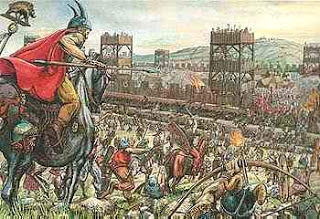
52 BC Vercingetorix, leader of the Gauls, surrendered to the Romans under Julius Caesar, ending the siege and Battle of Alesia.

1226 Saint Francis of Assisi, the great Roman Catholic churchman and founder of the Franciscan order died at his beloved Poriuncula chapel at age 44.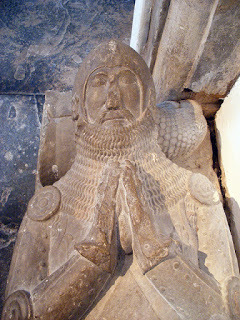
1283 Dafydd ap Gruffydd, prince of Gwynedd in Wales, was executed for what from that time onwards would be described as high treason against the King. King Edward I ensured that Dafydd's death was to be slow and agonizing, and also historic; he became the first prominent person in recorded history to have been hanged, drawn and quartered, preceded by a number of minor knights earlier in the thirteenth century.

52 BC Vercingetorix, leader of the Gauls, surrendered to the Romans under Julius Caesar, ending the siege and Battle of Alesia.

1226 Saint Francis of Assisi, the great Roman Catholic churchman and founder of the Franciscan order died at his beloved Poriuncula chapel at age 44.

1283 Dafydd ap Gruffydd, prince of Gwynedd in Wales, was executed for what from that time onwards would be described as high treason against the King. King Edward I ensured that Dafydd's death was to be slow and agonizing, and also historic; he became the first prominent person in recorded history to have been hanged, drawn and quartered, preceded by a number of minor knights earlier in the thirteenth century.
Published on October 03, 2015 00:30
October 2, 2015
Tutankhamun Death Mask was Made for Nefertiti, Archaeologist says
Ancient Origins
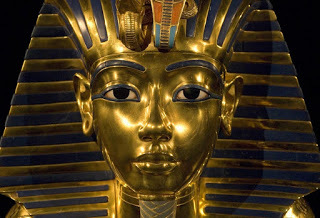 A new analysis of Tutankhamun’s golden death mask has led to a radical new theory – the mask was originally made for Nefertiti, step mother of Tutankhamun, as a co-regent to her husband king Akhenaten.
A new analysis of Tutankhamun’s golden death mask has led to a radical new theory – the mask was originally made for Nefertiti, step mother of Tutankhamun, as a co-regent to her husband king Akhenaten.Ahram Online reports that archaeologist Nicholas Reeves was examining the back of Tutankhamun’s death mask when he noticed that the face did not match the opposite side – the type of gold and the material used for the blue color are different between the front and the back. Reeves also noted that the ears contain holes used to hang earrings.
“There is no image of any ancient Egyptian king wearing earrings,” Reeves told Ahram Online, citing this as evidence that it was made for a female.
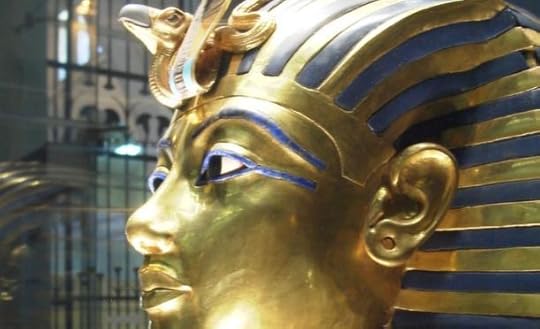 The mask contains holes in the ear lobes used for hanging earrings (
Wikipedia
)During a press conference held at the State Information Authority in Heliopolis, Reeves said that the inscription had been changed:
The mask contains holes in the ear lobes used for hanging earrings (
Wikipedia
)During a press conference held at the State Information Authority in Heliopolis, Reeves said that the inscription had been changed:“Looking at the mask again I can see that the inscription on the cartouch has been changed, meaning that all these treasures found in Tutankhamun’s tomb were originally made for Nefertiti as a co-regent to her husband king Akhenaten, and not for Tutankhamun as previously thought,” Reeves said [via Ahram Online].Dr Reeves is involved in the current search for hidden chambers within Tutankhamun’s tomb. The British archaeologist claims that two extra rooms have been identified hidden in the walls of the tomb, one of which Reeves maintains is the long-lost burial chamber of Nefertiti.
The Mysterious Disappearance of Nefertiti, Ruler of the Nile The Elusive Tomb of Queen Nefertiti may lie behind the walls of Tutankhamun's Burial Chamber The Search Continues: Scientists to Use Radar in Hunt for the Tomb of Nefertiti
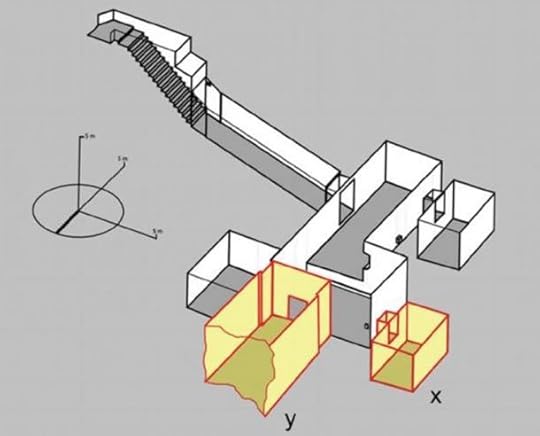 Theban Mapping Project's diagram of King Tutankamun's known tomb, in gray, and two possible new rooms in yellow and red, one of which, a researcher says, cold be Queen Nefertiti's burial chamber.Nefertiti was the chief consort of the Egyptian Pharaoh Akhenaten (formerly Amenhotep IV), who reigned from approximately 1353 to 1336 BC. Known as the Ruler of the Nile and Daughter of Gods, she acquired unprecedented power, and is believed to have held equal status to the pharaoh himself. However, much controversy lingers about Nefertiti after the twelfth regal year of Akhenaten, when her name vanishes from the pages of history. Despite numerous searches, her final resting place has never been found.
Theban Mapping Project's diagram of King Tutankamun's known tomb, in gray, and two possible new rooms in yellow and red, one of which, a researcher says, cold be Queen Nefertiti's burial chamber.Nefertiti was the chief consort of the Egyptian Pharaoh Akhenaten (formerly Amenhotep IV), who reigned from approximately 1353 to 1336 BC. Known as the Ruler of the Nile and Daughter of Gods, she acquired unprecedented power, and is believed to have held equal status to the pharaoh himself. However, much controversy lingers about Nefertiti after the twelfth regal year of Akhenaten, when her name vanishes from the pages of history. Despite numerous searches, her final resting place has never been found.Next month, radar and thermal imaging will be used to scan the tomb to confirm whether Reeves’ theory is correct. Minister of Antiquities Mamdouh Eldamaty is quoted as saying: “When we find Nefertiti, I think it will be more important than the discovery of King Tutankhamun himself".
Featured image: Tutankhamun’s death mask ( Harry Potts / flickr )
By April Holloway
Published on October 02, 2015 06:47
Bronze Age Britons Mummified the Dead: Smoked over Fires, Preserved in Bogs
Ancient Origins
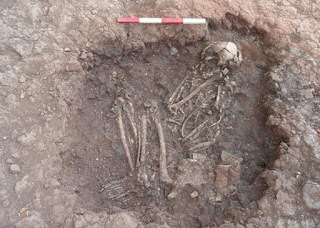 Mummification may have been more common in Bronze Age Britain than previously believed, and the ancient Britons may have purposefully mummified their dead with unknown funerary rituals—but why and how still eludes archaeologists.
Mummification may have been more common in Bronze Age Britain than previously believed, and the ancient Britons may have purposefully mummified their dead with unknown funerary rituals—but why and how still eludes archaeologists.
According to science news site Phys.org, researchers studying Bronze Age skeletons from various sites across the UK found that mummification may have been a wide-spread funerary practice in ancient Britain.
A team comprised of researchers from University of Sheffield, University of Manchester and University College London, compared 301 skeletal remains from prehistoric Europe with preserved mummies from northern Yemen and Ireland.
Dr. Thomas Booth, bioarchaeologist of the Department of Earth Sciences at London's Natural History Museum said that microscopic bone studies indicated that some bodies buried at sites throughout Britain were intentionally mummified between 4,200 and 2,750 years ago, reports ScienceNews magazine.
Bronze Age steam room may have been used by select Orkney settlers for rites Walk Like An Egyptian… Scientists Preserve Modern Human Leg using Ancient Egyptian Methods Body of 4,000-year-old teenager near Stonehenge may give clues about Bronze Age lives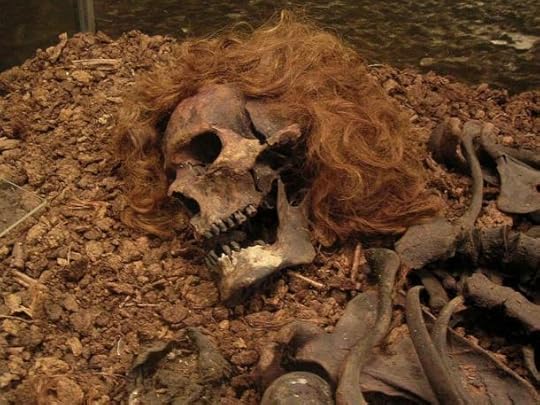 The Bocksten Man is the remains of an ancient male body found in a bog in Sweden. His remains were partially preserved in a bog. (
CC BY 2.0
)Gut ReactionsGut bacteria was the key to unlocking which bodies had been intentionally preserved, and which were simply buried at death to decompose naturally.
The Bocksten Man is the remains of an ancient male body found in a bog in Sweden. His remains were partially preserved in a bog. (
CC BY 2.0
)Gut ReactionsGut bacteria was the key to unlocking which bodies had been intentionally preserved, and which were simply buried at death to decompose naturally.
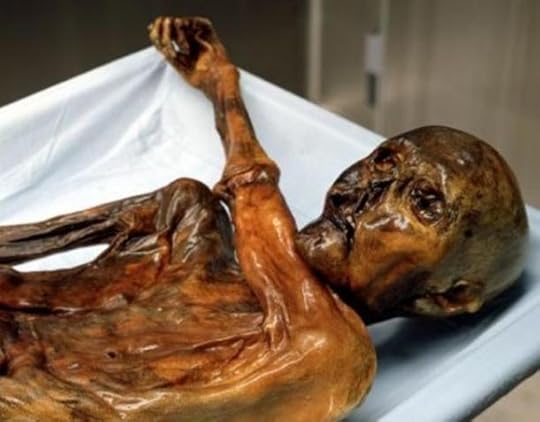 Ötzi the Iceman, a man from about 3300 BC, famously a naturally preserved body, was found in a glacier in the Alps. (© South Tyrol Museum of Archaeology,
Fair Use
)The team’s work has been detailed this week in the archaeology journal,
Antiquity
. It reveals that bones from 16 out of 34 Bronze Age Britons had little to no bacterial damage. This strongly suggests that either artificial or natural preservation blocked rapid decomposition of the flesh.
Ötzi the Iceman, a man from about 3300 BC, famously a naturally preserved body, was found in a glacier in the Alps. (© South Tyrol Museum of Archaeology,
Fair Use
)The team’s work has been detailed this week in the archaeology journal,
Antiquity
. It reveals that bones from 16 out of 34 Bronze Age Britons had little to no bacterial damage. This strongly suggests that either artificial or natural preservation blocked rapid decomposition of the flesh.
Making Mummies in the Bronze AgeThis evidence says to researchers the ancient Britons purposefully mummified their dead, although without the elaborate rituals and chemicals of the ancient Egyptians. Instead of using plant resins or wrappings, it’s thought the Britons may have smoked dead bodies over a fire, or brined them in peat bogs. If bodies were mummified or preserved intentionally in other ways in prehistoric times, the wet climate conditions of Britain would have long ago destroyed evidence of the burials.
Scientists from Zurich, Switzerland demonstrated this earlier this year as they attempted to mummify human legs from a recently deceased donor using both Ancient Egyptian and natural mummification methods. The naturally mummified leg succumbed to decomposition after a single week in the cool and damp Zurich lab and without the traditional preservative salts and arid conditions of Egypt.
According to Phys.org, Dr. Booth noted, “Our research shows that smoking over a fire and purposeful burial within a peat bog are among some of the techniques ancient Britons may have used to mummify their dead. Other techniques could have included evisceration, in which organs were removed shortly after death.
Science magazine Smithsonian writes, “Inca, for instance, mummified their rulers to allow them to remain at their posts, while some Buddhist monks may even self-mummify to achieve the ultimate state of enlightenment. But with a lack of associated burial artifacts, it's unclear what would have motivated Bronze Age Britons to mummify their dead.”
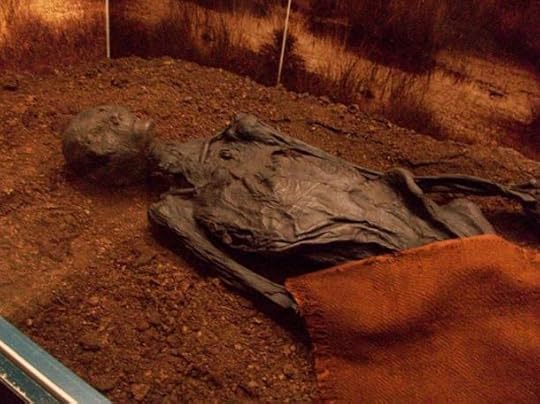 The naturally mummified bog body of the Man of Rendswühren from Germany, dated to the Roman Iron Age of the 1st or 2nd century AD. (
CC BY-SA 3.0
)Continuing studies at other prehistoric sites throughout Europe may reveal why Bronze Age Britons sought to preserve their dead, why they selected the people they did, and exactly how they went about it. This and other work is hoped to provide insight into the ancient beliefs and funerary practices of the European ancestors.
The naturally mummified bog body of the Man of Rendswühren from Germany, dated to the Roman Iron Age of the 1st or 2nd century AD. (
CC BY-SA 3.0
)Continuing studies at other prehistoric sites throughout Europe may reveal why Bronze Age Britons sought to preserve their dead, why they selected the people they did, and exactly how they went about it. This and other work is hoped to provide insight into the ancient beliefs and funerary practices of the European ancestors.
Featured Image: Bronze Age skeleton found at Stragglethorpe, during archaeological work on the Highways Agency scheme, England. Representational image only. ( CC BY 2.0 )
By Liz Leafloor
 Mummification may have been more common in Bronze Age Britain than previously believed, and the ancient Britons may have purposefully mummified their dead with unknown funerary rituals—but why and how still eludes archaeologists.
Mummification may have been more common in Bronze Age Britain than previously believed, and the ancient Britons may have purposefully mummified their dead with unknown funerary rituals—but why and how still eludes archaeologists.According to science news site Phys.org, researchers studying Bronze Age skeletons from various sites across the UK found that mummification may have been a wide-spread funerary practice in ancient Britain.
A team comprised of researchers from University of Sheffield, University of Manchester and University College London, compared 301 skeletal remains from prehistoric Europe with preserved mummies from northern Yemen and Ireland.
Dr. Thomas Booth, bioarchaeologist of the Department of Earth Sciences at London's Natural History Museum said that microscopic bone studies indicated that some bodies buried at sites throughout Britain were intentionally mummified between 4,200 and 2,750 years ago, reports ScienceNews magazine.
Bronze Age steam room may have been used by select Orkney settlers for rites Walk Like An Egyptian… Scientists Preserve Modern Human Leg using Ancient Egyptian Methods Body of 4,000-year-old teenager near Stonehenge may give clues about Bronze Age lives
 The Bocksten Man is the remains of an ancient male body found in a bog in Sweden. His remains were partially preserved in a bog. (
CC BY 2.0
)Gut ReactionsGut bacteria was the key to unlocking which bodies had been intentionally preserved, and which were simply buried at death to decompose naturally.
The Bocksten Man is the remains of an ancient male body found in a bog in Sweden. His remains were partially preserved in a bog. (
CC BY 2.0
)Gut ReactionsGut bacteria was the key to unlocking which bodies had been intentionally preserved, and which were simply buried at death to decompose naturally.“After you die and your cells start to break down, the kind of internal gates that keep your bacteria within their locales break down as well,” Booth told LiveScience.Microscopic tunnels and holes are created in the bones by the bacteria—a process called bacterial bioerosion. If a body has been purposefully mummified with either man-made methods or through natural preservation (such as lying in a peat bog, or dying in icy or arid conditions), the bones tend to have few to no discernable holes.
"Your bacteria — they have no loyalty. They start to attack your soft tissues in the first few hours after death,” he said.
 Ötzi the Iceman, a man from about 3300 BC, famously a naturally preserved body, was found in a glacier in the Alps. (© South Tyrol Museum of Archaeology,
Fair Use
)The team’s work has been detailed this week in the archaeology journal,
Antiquity
. It reveals that bones from 16 out of 34 Bronze Age Britons had little to no bacterial damage. This strongly suggests that either artificial or natural preservation blocked rapid decomposition of the flesh.
Ötzi the Iceman, a man from about 3300 BC, famously a naturally preserved body, was found in a glacier in the Alps. (© South Tyrol Museum of Archaeology,
Fair Use
)The team’s work has been detailed this week in the archaeology journal,
Antiquity
. It reveals that bones from 16 out of 34 Bronze Age Britons had little to no bacterial damage. This strongly suggests that either artificial or natural preservation blocked rapid decomposition of the flesh.Making Mummies in the Bronze AgeThis evidence says to researchers the ancient Britons purposefully mummified their dead, although without the elaborate rituals and chemicals of the ancient Egyptians. Instead of using plant resins or wrappings, it’s thought the Britons may have smoked dead bodies over a fire, or brined them in peat bogs. If bodies were mummified or preserved intentionally in other ways in prehistoric times, the wet climate conditions of Britain would have long ago destroyed evidence of the burials.
Scientists from Zurich, Switzerland demonstrated this earlier this year as they attempted to mummify human legs from a recently deceased donor using both Ancient Egyptian and natural mummification methods. The naturally mummified leg succumbed to decomposition after a single week in the cool and damp Zurich lab and without the traditional preservative salts and arid conditions of Egypt.
According to Phys.org, Dr. Booth noted, “Our research shows that smoking over a fire and purposeful burial within a peat bog are among some of the techniques ancient Britons may have used to mummify their dead. Other techniques could have included evisceration, in which organs were removed shortly after death.
“The idea that British and potentially European Bronze Age communities invested resources in mummifying and curating a proportion of their dead fundamentally alters our perceptions of funerary ritual and belief in this period.”The practice of sacrifice in Iron Age Britain Stone Age Britons traded with European farmers 8,000 years ago Fire Mummies - The Smoked Human Remains of the Kabayan Caves Cultural Motivations Remain MysteriousIt has not yet been determined why the prehistoric Britons might have practiced mummification of their dead. Intentional mummification is widespread in societies around the world, and can be seen in the artifacts and remains of various ancient cultures.
Science magazine Smithsonian writes, “Inca, for instance, mummified their rulers to allow them to remain at their posts, while some Buddhist monks may even self-mummify to achieve the ultimate state of enlightenment. But with a lack of associated burial artifacts, it's unclear what would have motivated Bronze Age Britons to mummify their dead.”
 The naturally mummified bog body of the Man of Rendswühren from Germany, dated to the Roman Iron Age of the 1st or 2nd century AD. (
CC BY-SA 3.0
)Continuing studies at other prehistoric sites throughout Europe may reveal why Bronze Age Britons sought to preserve their dead, why they selected the people they did, and exactly how they went about it. This and other work is hoped to provide insight into the ancient beliefs and funerary practices of the European ancestors.
The naturally mummified bog body of the Man of Rendswühren from Germany, dated to the Roman Iron Age of the 1st or 2nd century AD. (
CC BY-SA 3.0
)Continuing studies at other prehistoric sites throughout Europe may reveal why Bronze Age Britons sought to preserve their dead, why they selected the people they did, and exactly how they went about it. This and other work is hoped to provide insight into the ancient beliefs and funerary practices of the European ancestors.Featured Image: Bronze Age skeleton found at Stragglethorpe, during archaeological work on the Highways Agency scheme, England. Representational image only. ( CC BY 2.0 )
By Liz Leafloor
Published on October 02, 2015 06:44
Ancient Amphipolis Tomb was Commissioned by Alexander the Great for his Closest Friend and General, Hephaestion, New Evidence Shows
Ancient Origins
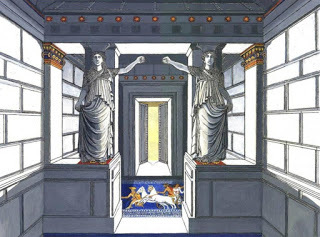 New evidence has emerged that the massive underground tomb in Amphipolis, Greece, which was hailed last year as the archaeological discovery of the decade, was commissioned by Alexander the Great for his close companion and general in his army, Hephaestion.
New evidence has emerged that the massive underground tomb in Amphipolis, Greece, which was hailed last year as the archaeological discovery of the decade, was commissioned by Alexander the Great for his close companion and general in his army, Hephaestion.
The Amphipolis Tomb, which lies within the Kasta Hill burial mound, approximately 100 kilometres east of Thessaloniki in Greece, captured worldwide attention last year when two marble sphinxes were found guarding its entrance. It lies in what was once the ancient city of Amphipolis, conquered by Philip II of Macedon, father of Alexander the Great, in 357 BC, and dates back to the fourth century B.C. The tomb, measuring 500 metres (1,640 feet) in circumference, was found to contain sculptures of caryatids, an ornate mosaic, and coins featuring the face of Alexander the Great.
Head archaeologist Katerina Peristeri long suggested that the tomb may have been commissioned for a general in Alexander the Great’s army. However, the discovery of rosettes painted in blue, red, and yellow, which are similar to those found on the coffin from the tomb believed to belong to Philip II, Alexander the Great’s father, suggested that the tomb at Amphipolis may have instead belonged to a Macedonian royal, with the most popular theory pointing to Olympias, Alexander’s mother.
 Amphipolis Tomb by
Greektoys.org
(update) on Sketchfab.New inscriptions foundGreek news site Ekathimerini reports that new evidence has emerged that may finally solve the mystery of the tomb’s original owner.
Amphipolis Tomb by
Greektoys.org
(update) on Sketchfab.New inscriptions foundGreek news site Ekathimerini reports that new evidence has emerged that may finally solve the mystery of the tomb’s original owner.
During a conference in Thessaloniki, Peristeri and her head architect Michalis Lefantzis announced that they found three inscriptions within the Amphipolis tomb with the monogram of Hephaestion, a general, and the closest friend of Alexander the Great. The inscriptions are project contracts for the construction of the monument.
According to the Greek Reporter, the inscriptions suggest that the monument was commissioned by a powerful individual of that era, and Peristeri maintains that individual may have been Alexander himself.
 The monogram of Hephaestion found in three separate inscriptions within the Amphipolis tomb. Credit: Greek Ministry of CultureHephaestion, general in the army of Alexander the GreatHephaestion was a Macedonian nobleman that grew up with Alexander, studying with him under the tutelage of Aristotle. They became close personal friends, as well as comrades. Hephaestion became a member of Alexander’s personal bodyguard and went on to command the Companion cavalry. He was entrusted with many important roles, including diplomatic missions, the bridging of major rivers, sieges and the foundation of new settlements.
The monogram of Hephaestion found in three separate inscriptions within the Amphipolis tomb. Credit: Greek Ministry of CultureHephaestion, general in the army of Alexander the GreatHephaestion was a Macedonian nobleman that grew up with Alexander, studying with him under the tutelage of Aristotle. They became close personal friends, as well as comrades. Hephaestion became a member of Alexander’s personal bodyguard and went on to command the Companion cavalry. He was entrusted with many important roles, including diplomatic missions, the bridging of major rivers, sieges and the foundation of new settlements.
When Hephaestion died suddenly in Ecbatana, Iran, in 324 BC, Alexander petitioned the oracle at Siwa to grant him divine status, and organized an elaborate funeral at Babylon, in which Hephaestion was said to have been cremated in the presence of the entire army. According to ancient historian Plutarch, Alexander then ordered a series of monuments to be built for Hephaestion across his empire.

A painting by Charles Le Brun depicting Alexander and Hephaestion (in red cloak), facing Porus, during the Battle of the Hydaspes.
While the Amphipolis monument may have been constructed in Hephaestions honor, Peristeri maintains that there is no evidence that Hephaestions remains were ever buried there.
When a sarcophagus was finally uncovered within the Amphipolis tomb, archaeologists found a total of five skeletons – an elderly woman, two men, a newborn baby, and the cremated remains of an individual of unknown age and gender.
The tomb is believed to have been in use from the fourth century BC until Roman times, and is known to have been looted in antiquity, so there is no way to know who those five individuals were.
Featured Image: Artistic representation of the caryatids in the Amphipolis tomb
By April Holloway
 New evidence has emerged that the massive underground tomb in Amphipolis, Greece, which was hailed last year as the archaeological discovery of the decade, was commissioned by Alexander the Great for his close companion and general in his army, Hephaestion.
New evidence has emerged that the massive underground tomb in Amphipolis, Greece, which was hailed last year as the archaeological discovery of the decade, was commissioned by Alexander the Great for his close companion and general in his army, Hephaestion.The Amphipolis Tomb, which lies within the Kasta Hill burial mound, approximately 100 kilometres east of Thessaloniki in Greece, captured worldwide attention last year when two marble sphinxes were found guarding its entrance. It lies in what was once the ancient city of Amphipolis, conquered by Philip II of Macedon, father of Alexander the Great, in 357 BC, and dates back to the fourth century B.C. The tomb, measuring 500 metres (1,640 feet) in circumference, was found to contain sculptures of caryatids, an ornate mosaic, and coins featuring the face of Alexander the Great.
Head archaeologist Katerina Peristeri long suggested that the tomb may have been commissioned for a general in Alexander the Great’s army. However, the discovery of rosettes painted in blue, red, and yellow, which are similar to those found on the coffin from the tomb believed to belong to Philip II, Alexander the Great’s father, suggested that the tomb at Amphipolis may have instead belonged to a Macedonian royal, with the most popular theory pointing to Olympias, Alexander’s mother.
 Amphipolis Tomb by
Greektoys.org
(update) on Sketchfab.New inscriptions foundGreek news site Ekathimerini reports that new evidence has emerged that may finally solve the mystery of the tomb’s original owner.
Amphipolis Tomb by
Greektoys.org
(update) on Sketchfab.New inscriptions foundGreek news site Ekathimerini reports that new evidence has emerged that may finally solve the mystery of the tomb’s original owner.During a conference in Thessaloniki, Peristeri and her head architect Michalis Lefantzis announced that they found three inscriptions within the Amphipolis tomb with the monogram of Hephaestion, a general, and the closest friend of Alexander the Great. The inscriptions are project contracts for the construction of the monument.
According to the Greek Reporter, the inscriptions suggest that the monument was commissioned by a powerful individual of that era, and Peristeri maintains that individual may have been Alexander himself.
 The monogram of Hephaestion found in three separate inscriptions within the Amphipolis tomb. Credit: Greek Ministry of CultureHephaestion, general in the army of Alexander the GreatHephaestion was a Macedonian nobleman that grew up with Alexander, studying with him under the tutelage of Aristotle. They became close personal friends, as well as comrades. Hephaestion became a member of Alexander’s personal bodyguard and went on to command the Companion cavalry. He was entrusted with many important roles, including diplomatic missions, the bridging of major rivers, sieges and the foundation of new settlements.
The monogram of Hephaestion found in three separate inscriptions within the Amphipolis tomb. Credit: Greek Ministry of CultureHephaestion, general in the army of Alexander the GreatHephaestion was a Macedonian nobleman that grew up with Alexander, studying with him under the tutelage of Aristotle. They became close personal friends, as well as comrades. Hephaestion became a member of Alexander’s personal bodyguard and went on to command the Companion cavalry. He was entrusted with many important roles, including diplomatic missions, the bridging of major rivers, sieges and the foundation of new settlements.When Hephaestion died suddenly in Ecbatana, Iran, in 324 BC, Alexander petitioned the oracle at Siwa to grant him divine status, and organized an elaborate funeral at Babylon, in which Hephaestion was said to have been cremated in the presence of the entire army. According to ancient historian Plutarch, Alexander then ordered a series of monuments to be built for Hephaestion across his empire.

A painting by Charles Le Brun depicting Alexander and Hephaestion (in red cloak), facing Porus, during the Battle of the Hydaspes.
While the Amphipolis monument may have been constructed in Hephaestions honor, Peristeri maintains that there is no evidence that Hephaestions remains were ever buried there.
When a sarcophagus was finally uncovered within the Amphipolis tomb, archaeologists found a total of five skeletons – an elderly woman, two men, a newborn baby, and the cremated remains of an individual of unknown age and gender.
The tomb is believed to have been in use from the fourth century BC until Roman times, and is known to have been looted in antiquity, so there is no way to know who those five individuals were.
Featured Image: Artistic representation of the caryatids in the Amphipolis tomb
By April Holloway
Published on October 02, 2015 06:42
Book Launch - Cuckoo Clock New York, by Elisabeth Marrion

Kristallnacht 9 November 1938. Doctor Esther Rosenthal’s husband has just enough time to whisper to her before the SA pulls him out of the door and slams it shut behind him.
Esther has to leave Germany in a hurry and embarks on a journey taking her through Holland, England, and ultimately to the USA.
In Holland she meets a group of children from a Berlin orphanage, the first children to go to England on the Kindertransport. Together with her father Mordechai she joins them on their crossing and accompanies them to Harwich.
The Kindertransport comes to an abrupt end on the outbreak of World War II. What will happen to the children still in Harwich without a new permanent or foster home?
‘Cuckoo Clock – New York: Esther’s Story‘, is the third book in the Unbroken Bonds series.
Amazon UK
Amazon US
Published on October 02, 2015 02:30
History Trivia - England's Henry VII invades France
October 2

1187 Sultan Saladin, captured Jerusalem which brought about the Third Crusade.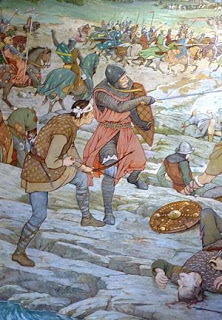
1263 The Battle of Largs was fought between Norwegians and Scots. It was the most important military engagement of the Scottish-Norwegian War. The Norwegian forces were led by King Håkon Håkonsson and the Scottish forces by King Alexander III. The result was inconclusive, but in the long term favored the Scots.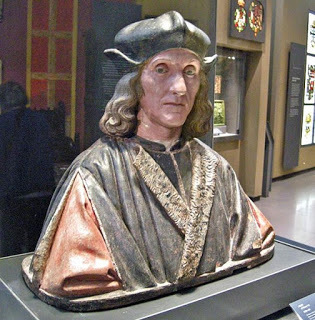
1492 King Henry VII of England invaded France. This act of war was a bluff by Henry, as he had no intention of fighting over the winter. However, as France became more concerned with the Italian Wars, the French were happy to agree to the Treaty of Etaples.

1187 Sultan Saladin, captured Jerusalem which brought about the Third Crusade.

1263 The Battle of Largs was fought between Norwegians and Scots. It was the most important military engagement of the Scottish-Norwegian War. The Norwegian forces were led by King Håkon Håkonsson and the Scottish forces by King Alexander III. The result was inconclusive, but in the long term favored the Scots.

1492 King Henry VII of England invaded France. This act of war was a bluff by Henry, as he had no intention of fighting over the winter. However, as France became more concerned with the Italian Wars, the French were happy to agree to the Treaty of Etaples.
Published on October 02, 2015 01:30
October 1, 2015
50 Graves Uncovered at Medieval Pilgrimage Site in England
Live Science
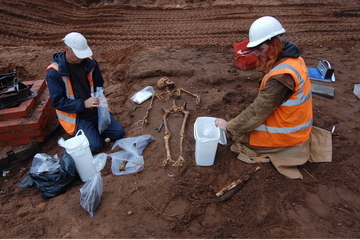
 Archaeologists excavate a grave near Lichfield Cathedral. Most of the remains of the people in the graves show that the individuals were buried lying on their backs.
Archaeologists excavate a grave near Lichfield Cathedral. Most of the remains of the people in the graves show that the individuals were buried lying on their backs.
Credit: Archaeology Warwickshire | Warwickshire County Council
The skeletal remains of about 50 medieval individuals have been discovered in shallow graves near the pilgrimage site of a famous seventh-century saint in England.
The human remains, which have been exhumed, may help archaeologists learn more about the medieval era, according to Archaeology Warwickshire, an archaeology and excavation firm. The company plans to study each skeleton to determine its sex and approximate age, and to identify evidence of injuries or diseases preserved in the bones, said Stuart Palmer, the business manager of Archaeology Warwickshire.
"The teeth will give us a lot of information about diet, as well," Palmer told Live Science. "There's a potential for more in-depth study, but we first have to assess the quality of material to see if it's worth trying to do." [See Photos of the Medieval Graves near Lichfield Cathedral
Archaeologists with the firm discovered the burials in early August. They received a commission to survey the land around an almshouse, located outside the gates of the medieval city of Lichfield, located in the West Midlands. During medieval times, pilgrims traveled to Lichfield to visit its famed three-spired cathedral from the 12th century, which held the tomb of St. Chad.
Lichfield closed its city gates every night about 9 p.m., and pilgrims who arrived after that time would have stayed in the almshouse, called the Hospital of St. John Baptist without the Barrs (the barrs referred to the city gates).
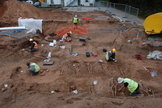 [image error]
[image error]
 Archaeologists found the shallow graves during a construction project in August. The graves are relatively shallow — just about 1.6 feet (0.5 meters) below ground.
Archaeologists found the shallow graves during a construction project in August. The graves are relatively shallow — just about 1.6 feet (0.5 meters) below ground.
Credit: Archaeology Warwickshire | Warwickshire County CouncilView full size imageArchaeology Warwickshire surveyed the grounds around the almshouse this summer, just before a planned expansion of the compound. The archaeologists expected to find some graves but "we weren't really expecting the volume and quantity that we got," Palmer said.
Perhaps there were so many bodies because St. Chad had a large following — the English clergyman founded the monastery at Lichfield, served as its abbot and bishop and is credited with converting the ancient English kingdom of Mercia to Christianity, according to the Encyclopedia Britannica. After he died of the plague in A.D. 672, the church canonized him as a saint, and people reported miracles taking place at his tomb in Lichfield, according to the Encyclopedia Britannica.
It's unknown whether the pilgrims ever made it inside the city walls to see St. Chad's tomb. During medieval times, pilgrims traveled far and wide to see relics, often bones, of saints.
"People came from miles to see them," Palmer said. "They're [supposed to have] some curative quality to them — maybe you'll get to see some good in heaven or on the way to heaven."
The buried individuals — adults and children alike — may have hoped that the power of the relics would cure them of an ailment, Palmer said. But some of them passed away during their travels. The graves are shallow, some no more than 1.6 feet (0.5 meters) deep. Most of the individuals were laid flat on their backs, arranged in rows, and covered with dirt, he said.
Archaeology Warwickshire received a yearlong permit from the Ministry of Justice to study the remains, but many of the skeletons are not in good shape because they were buried in acidic soil, which is typical of dirt in the area, Palmer said.
If the bones are in good condition, the archaeologists may analyze their DNA and isotopes (variants of a particular element), which can tell researchers where the pilgrims lived previously. After that, the skeletons will go to a museum, he said.

 Archaeologists excavate a grave near Lichfield Cathedral. Most of the remains of the people in the graves show that the individuals were buried lying on their backs.
Archaeologists excavate a grave near Lichfield Cathedral. Most of the remains of the people in the graves show that the individuals were buried lying on their backs. Credit: Archaeology Warwickshire | Warwickshire County Council
The skeletal remains of about 50 medieval individuals have been discovered in shallow graves near the pilgrimage site of a famous seventh-century saint in England.
The human remains, which have been exhumed, may help archaeologists learn more about the medieval era, according to Archaeology Warwickshire, an archaeology and excavation firm. The company plans to study each skeleton to determine its sex and approximate age, and to identify evidence of injuries or diseases preserved in the bones, said Stuart Palmer, the business manager of Archaeology Warwickshire.
"The teeth will give us a lot of information about diet, as well," Palmer told Live Science. "There's a potential for more in-depth study, but we first have to assess the quality of material to see if it's worth trying to do." [See Photos of the Medieval Graves near Lichfield Cathedral
Archaeologists with the firm discovered the burials in early August. They received a commission to survey the land around an almshouse, located outside the gates of the medieval city of Lichfield, located in the West Midlands. During medieval times, pilgrims traveled to Lichfield to visit its famed three-spired cathedral from the 12th century, which held the tomb of St. Chad.
Lichfield closed its city gates every night about 9 p.m., and pilgrims who arrived after that time would have stayed in the almshouse, called the Hospital of St. John Baptist without the Barrs (the barrs referred to the city gates).
 [image error]
[image error]
 Archaeologists found the shallow graves during a construction project in August. The graves are relatively shallow — just about 1.6 feet (0.5 meters) below ground.
Archaeologists found the shallow graves during a construction project in August. The graves are relatively shallow — just about 1.6 feet (0.5 meters) below ground.Credit: Archaeology Warwickshire | Warwickshire County CouncilView full size imageArchaeology Warwickshire surveyed the grounds around the almshouse this summer, just before a planned expansion of the compound. The archaeologists expected to find some graves but "we weren't really expecting the volume and quantity that we got," Palmer said.
Perhaps there were so many bodies because St. Chad had a large following — the English clergyman founded the monastery at Lichfield, served as its abbot and bishop and is credited with converting the ancient English kingdom of Mercia to Christianity, according to the Encyclopedia Britannica. After he died of the plague in A.D. 672, the church canonized him as a saint, and people reported miracles taking place at his tomb in Lichfield, according to the Encyclopedia Britannica.
It's unknown whether the pilgrims ever made it inside the city walls to see St. Chad's tomb. During medieval times, pilgrims traveled far and wide to see relics, often bones, of saints.
"People came from miles to see them," Palmer said. "They're [supposed to have] some curative quality to them — maybe you'll get to see some good in heaven or on the way to heaven."
The buried individuals — adults and children alike — may have hoped that the power of the relics would cure them of an ailment, Palmer said. But some of them passed away during their travels. The graves are shallow, some no more than 1.6 feet (0.5 meters) deep. Most of the individuals were laid flat on their backs, arranged in rows, and covered with dirt, he said.
Archaeology Warwickshire received a yearlong permit from the Ministry of Justice to study the remains, but many of the skeletons are not in good shape because they were buried in acidic soil, which is typical of dirt in the area, Palmer said.
If the bones are in good condition, the archaeologists may analyze their DNA and isotopes (variants of a particular element), which can tell researchers where the pilgrims lived previously. After that, the skeletons will go to a museum, he said.
Published on October 01, 2015 05:27
Meet L.A. Punk Rocker Author Brenda Perlin on October 30, 2015 - 7:00 p.m. at Book Soup on Sunset Boulevard, West Hollywood, CA


If you are in the LA area please give us a visit at Book Soup in West Hollywood on Friday October 30 at 7:00pm.Tell them Billy Idol sent you
8818 Sunset Blvd. West Hollywood, Ca 90069 - 310.659.3110...
Bookseller To The Great & Infamous!Fifteen stories from the eighties set in Los Angeles, written by LA Punk Queen Brenda Perlin and her friends who lived every moment of an electric era in the City of Angels. That unique and precious time when punk rock was more than just a rebellion.
This is what Billy Idol had to say about L.A. Punk Rocker…
"Pretty wild chapter on me…maybe u shouldv’e written my book, good luck with it..BFI.”
Inside you’ll discover Billy Idol. Iggy Pop. X. U2. Bad Religion. Tales of local punk rockers on the brink of glorious fame. Late nights at the Roxy. Wild times at the Whiskey with some of the best rock ever. Here you’ll find the in-your-face attitude, the clothes, the fashion, the sex, the music as hard as nails and fast as lightning.
Brenda and her friends were somewhere every night queuing backstage, in hotel rooms with the band, partying on the streets…and avoiding irate parents on school nights!
It’s all here.
LAPunkRocker. The next thing to being there…

Amazon link

Published on October 01, 2015 01:30
History Trivia - Battle of Arbela - Alexander the Great victorious
October 1

331 BC, Alexander the Great defeated Persian emperor Darius III in the Battle of Arbela in Mesopotamia in one of the fifteen decisive battles of history.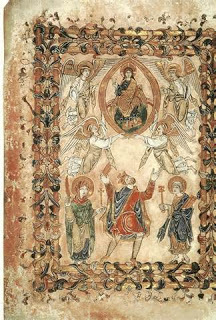
959 Edgar, King of the Mercians and Northumbrians, became King of the West Saxons and was then considered to be King of all England.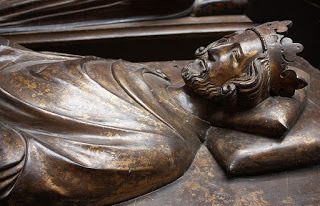
Henry III was born. King of England 1216-1264, his 56-year reign was one of the longest in history. The building of the Westminster Abbey was his most enduring moment.

331 BC, Alexander the Great defeated Persian emperor Darius III in the Battle of Arbela in Mesopotamia in one of the fifteen decisive battles of history.

959 Edgar, King of the Mercians and Northumbrians, became King of the West Saxons and was then considered to be King of all England.

Henry III was born. King of England 1216-1264, his 56-year reign was one of the longest in history. The building of the Westminster Abbey was his most enduring moment.
Published on October 01, 2015 01:00
September 30, 2015
History Trivia - Saint Jerome dead at age 80
September 30

420 Saint Jerome, one of the great scholars of the early Christian church, died at age 80. He is the patron saint of librarians and translators.
579 Pope Benedict I died. Famine raged in Italy on the heels of the Lombard invasion, and it is assumed that Benedict died in an attempt to cope with this problem. Benedict was succeeded by Pelagius II.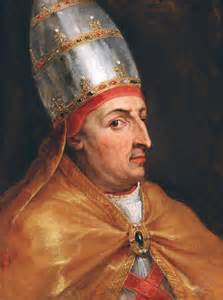
1227 Pope Nicholas IV, the first Franciscan pontiff, was born. Nicholas was pious and learned; he contributed to the artistic beauty of Rome, building particularly a palace beside Santa Maria Maggiore, the church in which he was buried and where Sixtus V erected an imposing monument to his memory. 1

420 Saint Jerome, one of the great scholars of the early Christian church, died at age 80. He is the patron saint of librarians and translators.

579 Pope Benedict I died. Famine raged in Italy on the heels of the Lombard invasion, and it is assumed that Benedict died in an attempt to cope with this problem. Benedict was succeeded by Pelagius II.

1227 Pope Nicholas IV, the first Franciscan pontiff, was born. Nicholas was pious and learned; he contributed to the artistic beauty of Rome, building particularly a palace beside Santa Maria Maggiore, the church in which he was buried and where Sixtus V erected an imposing monument to his memory. 1
Published on September 30, 2015 00:00



